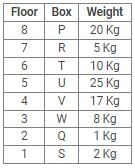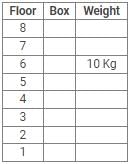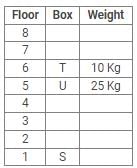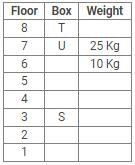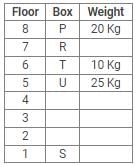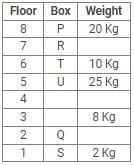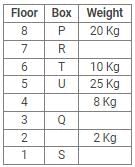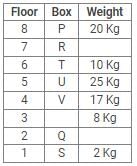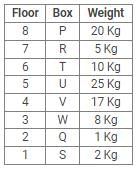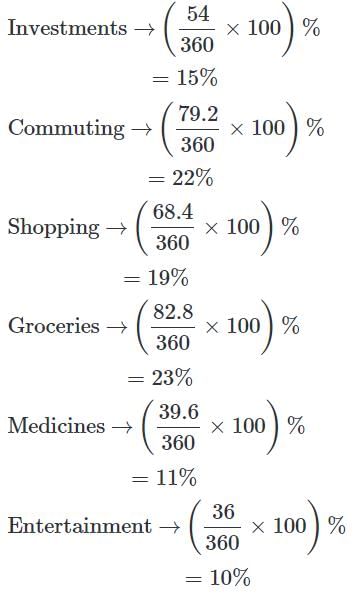ECGC PO Mock Test - 6 - Bank Exams MCQ
30 Questions MCQ Test - ECGC PO Mock Test - 6
Directions to Solve: In each of the questions below consists of a question and two statements numbered I and II given below it. You have to decide whether the data provided in the statements are sufficient to answer the question. Read both the statements and
Give answer:
- (A) If the data in statement I alone are sufficient to answer the question, while the data in statement II alone are not sufficient to answer the question
- (B) If the data in statement II alone are sufficient to answer the question, while the data in statement I alone are not sufficient to answer the question
- (C) If the data either in statement I alone or in statement II alone are sufficient to answer the question
- (D) If the data given in both statements I and II together are not sufficient to answer the question and
- (E) If the data in both statements I and II together are necessary to answer the question.
Question: On which day of the week was birthday of Sahil ?
Statements:
I.Sahil celebrated his birthday the very next day on which Arun celebrated his birthday.
II.The sister of Sahil was born on the third day of the week and two days after Sahil was born.
- (A) If the data in statement I alone are sufficient to answer the question, while the data in statement II alone are not sufficient to answer the question
- (B) If the data in statement II alone are sufficient to answer the question, while the data in statement I alone are not sufficient to answer the question
- (C) If the data either in statement I alone or in statement II alone are sufficient to answer the question
- (D) If the data given in both statements I and II together are not sufficient to answer the question and
- (E) If the data in both statements I and II together are necessary to answer the question.
Statements:
I.Sahil celebrated his birthday the very next day on which Arun celebrated his birthday.
II.The sister of Sahil was born on the third day of the week and two days after Sahil was born.
Directions to Solve: In each of the questions below consists of a question and two statements numbered I and II given below it. You have to decide whether the data provided in the statements are sufficient to answer the question. Read both the statements and
Give answer:
- (A) If the data in statement I alone are sufficient to answer the question, while the data in statement II alone are not sufficient to answer the question
- (B) If the data in statement II alone are sufficient to answer the question, while the data in statement I alone are not sufficient to answer the question
- (C) If the data either in statement I alone or in statement II alone are sufficient to answer the question
- (D) If the data given in both statements I and II together are not sufficient to answer the question and
- (E) If the data in both statements I and II together are necessary to answer the question.
Question: How many pages of book X did Robert read on Sunday ?
Statements:
I.The book has 300 pages out of which two-thirds were read by him before Sunday.
II.Robert read the last 40 pages of the book on the morning of Monday.
- (A) If the data in statement I alone are sufficient to answer the question, while the data in statement II alone are not sufficient to answer the question
- (B) If the data in statement II alone are sufficient to answer the question, while the data in statement I alone are not sufficient to answer the question
- (C) If the data either in statement I alone or in statement II alone are sufficient to answer the question
- (D) If the data given in both statements I and II together are not sufficient to answer the question and
- (E) If the data in both statements I and II together are necessary to answer the question.
Statements:
I.The book has 300 pages out of which two-thirds were read by him before Sunday.
II.Robert read the last 40 pages of the book on the morning of Monday.
A $ B means A is the father of B; A # B means A is the sister of B; A * B means A is the daughter of B and A @ B means A is the brother of B. Which of the following indicates that M is the wife of Q?
Pointing to a girl Sandeep said, "She is the daughter of the only sister of my father." How is sandeep related to the girl?
Directions: Study the following information carefully and answer the questions given below:
Eight boxes – P, Q, R, S, T, U, V and W were placed in an almirah of eight shelves. The bottom shelf was numbered 1 and the topmost shelf was numbered 8. Each of these boxes contained different amount of Sugar – 25 kg, 20 kg, 17 kg, 10 kg, 8 kg, 5 kg, 2 kg and 1 kg but not necessarily in the same order.
Box V was placed at one of the even numbered shelves and contained 17 kg of Sugar. The box which was placed on 6th shelf contained 10 kg of Sugar. Box Q was placed immediately below the box which contained 8 kg of Sugar and immediately above the box which contained 2 kg of Sugar. Box R was not the lightest and Box U, was the heaviest. Box R was placed above the shelf on which Box U was placed but not on the even numbered shelf. Box P, contained 20 kg of Sugar, and was placed either at the top or bottom shelf. There are three boxes between Box U and Box S and Box S was placed below the shelf on which Box U was placed. T was placed immediately above the box which was heaviest.
Q. How many box(es) were placed above the box which contained 25 Kg of Sugar?
Direction: In each question below is given a statement followed by two conclusions numbered I and II. You have to assume everything in the statement to be true, then consider the two conclusions together and decide which of them logically follows beyond a reasonable doubt from the information given in the statement.
Statements: Any student who does not behave properly while in the school brings bad name to himself and also for the school.
Conclusions:
- Such student should be removed from the school.
- Stricter discipline does not improve behaviour of the students.
Directions: Read the following information carefully and answer the questions.
Alex, Bravo, Charlie, Delta, Echo and Foxtrot joined six different colleges – UBS, SP JAIN, DAVIET, JBIMS, IIMA and IIMB and opted for six different courses in management – Marketing, Finance, Operations, HR, Logistics and General Management.
Each of them has a different educational qualification out of B. Tech, B.Sc, B.Com, C.A, BBM and BA.
The following information is available about them:
- Delta joined SP JAIN and did not take up Marketing or Logistics and is not a B. Tech.
- The person who joined IIMA opted for HR and is not a C.A or B.Sc.
- Foxtrot is a C.A and has taken Finance management.
- The person, who is a B.A graduate, joined JBIMS and took Logistics. Whereas, the person, who is a B.Com graduate, took up General Management.
- The person, who is a B. Tech graduate, has taken Operations Management and did not join UBS or DAVIET.
- Alex joined IIMB, Charlie is B.A graduate and Bravo took up HR.
Q. If Echo joined DAVIET, then the student who joined UBS, opted for:
The angry Arjun carried some arrows for fighting with Bheeshma. With half the arrows, he cut down the arrows thrown by Bheeshma on him and with six other arrows he killed the rath driver of Bheeshma. With one arrow each he knocked down respectively the rath, flag and bow of Bheeshma. Finally with one more than four times the square root of arrows he laid Bheeshma unconscious on an arrow bed. The total number of arrows that Arjun had is
What is the code of ‘7’ in a certain code?
I. ‘734’ stands for ‘DH%’ and ‘348’ stands for ‘D*%’ in that code.
II. ‘127’ stands for ‘H*$’ and ‘375’ stands for ‘&@H’ in that code.
Directions for questions: Based on the series of numbers given in the question, find the next / missing number in the series.
3, 9, 36, 180, ?
Directions: Study the following pie-chart carefully and answer the questions that follow:
Degreewise Break-up of Expenditure of a Family in a month
Total Amount Spent In a Month = Rs. 45800.
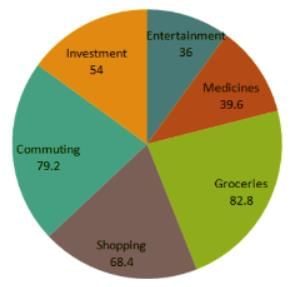
Q.What is the ratio of the amount spent by the family on medicine to the amount spent on groceries?
Read the each sentence to find out whether there is any grammatical error in it. The error, if any will be in one part of the sentence. The letter of that part is the answer. If there is no error, the answer is 'D'. (Ignore the errors of punctuation, if any).
In the following questions four alternatives are given for the idiom/phrase italicised and underlined in the sentence. Choose the alternative which best expresses the meaning of idiom/phrase.
Q. In the organised society of today no individual or nation can plough a lonely furrow.
Civilisation means outward….(21)… whereas culture means inward perfection. We may be…(22)...today, but we are not cultured. We have trains, aeroplanes and all the modern modes and ….(23).. . This is…(24)…on the road of materialism but we have lost our finer emotions. Civilisation has…..(25)…mystery and romance out of the heart of nature and …..(26)… her beauty and magic. It has placed…..(27)….power in the hands of man, making him a….(28)….. With a single atom or hydrogen bomb, he can rain death and ..(29)…… in millions of innocent creatures. Thus, he is out to….(30)…..himself with his own hands.
Q. Find the word most appropriate for Blank no. 21
Directions: Read the passage carefully and answer the questions that follow:
There is now no denying that the new government takes office amid a clear economic slowdown. The first macro data set released showed an under-performing economy with GDP growth falling to 5.8% in the fourth quarter of 2018-19 and pulling down the overall growth for the fiscal to a five-year low of 6.8%. Growth in gross value added (GVA), which is GDP minus taxes and subsidies, fell to 6.6% in 2018-19, pointing to a serious slowdown. If further confirmation were needed, the growth in core sector output — a set of eight major industrial sectors — fell to 2.6% in April, compared to 4.7% in the same month last year. And finally, unemployment data, controversially suppressed by the Union government so far, showed that joblessness was at a 45-year high of 6.1% in 2017-18. These numbers highlight the challenges ahead in drafting the Budget for 2019-20. The economy is beset by a consumption slowdown as reflected in the falling sales of everything from automobiles to consumer durables, even fast-moving consumer goods. Private investment is not taking off, while government spending, which kept the economy afloat during the last NDA government, was cut back in the last quarter of 2018-19 to meet the fiscal deficit target of 3.4%.
The good news is that inflation is undershooting the target and oil prices are on the retreat again. But the rural economy remains in distress, as seen by the 2.9% growth in agriculture last fiscal; the sector needs a good monsoon this year to bounce back. Overall economic growth in the first quarter of this fiscal is likely to remain subdued, and any improvement is unlikely until the late second quarter or the early third. There are not too many options before the new Finance Minister. In the near term, she has to boost consumption, which means putting more money in the hands of people. That, in turn, means cutting taxes, which is not easy given the commitment to rein in the fiscal deficit. In the medium term, Ms. Sitharaman has to take measures to boost private investment even as she opens up public spending again. These call for major reforms, starting with land acquisition and labour, corporate taxes by reducing exemptions and dropping rates, and nursing banks back to health. On the table will be options such as further recapitalisation of the ailing banks, and consolidation. The question, though, is where the money will come from. With tax revenues likely to be subdued owing to the slowdown, the Centre will have to look at alternative sources such as disinvestment. There may be little choice but to go big on privatisation. A rate cut by the Reserve Bank of India, widely expected this week, would certainly help boost sentiment. But it is the Budget that will really set the tone for the economy
Q. As per the passage, which of the following would lead to ‘putting more money in the hands of people’?
I. Decrease in tax rates.
II. Increase in inflation
III. Increase in private investment
Directions: Read the passage carefully and answer the questions that follow:
There is now no denying that the new government takes office amid a clear economic slowdown. The first macro data set released showed an under-performing economy with GDP growth falling to 5.8% in the fourth quarter of 2018-19 and pulling down the overall growth for the fiscal to a five-year low of 6.8%. Growth in gross value added (GVA), which is GDP minus taxes and subsidies, fell to 6.6% in 2018-19, pointing to a serious slowdown. If further confirmation were needed, the growth in core sector output — a set of eight major industrial sectors — fell to 2.6% in April, compared to 4.7% in the same month last year. And finally, unemployment data, controversially suppressed by the Union government so far, showed that joblessness was at a 45-year high of 6.1% in 2017-18. These numbers highlight the challenges ahead in drafting the Budget for 2019-20. The economy is beset by a consumption slowdown as reflected in the falling sales of everything from automobiles to consumer durables, even fast-moving consumer goods. Private investment is not taking off, while government spending, which kept the economy afloat during the last NDA government, was cut back in the last quarter of 2018-19 to meet the fiscal deficit target of 3.4%.
The good news is that inflation is undershooting the target and oil prices are on the retreat again. But the rural economy remains in distress, as seen by the 2.9% growth in agriculture last fiscal; the sector needs a good monsoon this year to bounce back. Overall economic growth in the first quarter of this fiscal is likely to remain subdued, and any improvement is unlikely until the late second quarter or the early third. There are not too many options before the new Finance Minister. In the near term, she has to boost consumption, which means putting more money in the hands of people. That, in turn, means cutting taxes, which is not easy given the commitment to rein in the fiscal deficit. In the medium term, Ms. Sitharaman has to take measures to boost private investment even as she opens up public spending again. These call for major reforms, starting with land acquisition and labour, corporate taxes by reducing exemptions and dropping rates, and nursing banks back to health. On the table will be options such as further recapitalisation of the ailing banks, and consolidation. The question, though, is where the money will come from. With tax revenues likely to be subdued owing to the slowdown, the Centre will have to look at alternative sources such as disinvestment. There may be little choice but to go big on privatisation. A rate cut by the Reserve Bank of India, widely expected this week, would certainly help boost sentiment. But it is the Budget that will really set the tone for the economy
Q. Which of the following, as per the passage, indicate a slowdown in the Indian economy?
I. Fall in sale levels of consumer durables
II. Negative growth in the core sector output
III. Fall in inflations levels
Directions: Out of the given alternatives, choose the one which can be substituted for the given words/sentence.
The plants and vegetation of a region
The most common method of entering text and numerical data into a computer system is through the use of a _________.
Software with malicious content, such as viruses, worms and trojan horses, is referred to as _______.
A self-replicating software on a computer called a ___________ has code that specifically copies itself into other executable codes or programs.
What is the minimum service requirement for receiving a pension under the Unified Pension Scheme (UPS)?



